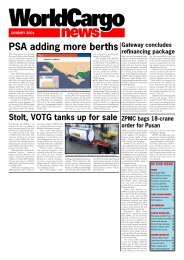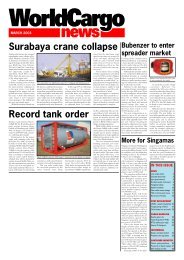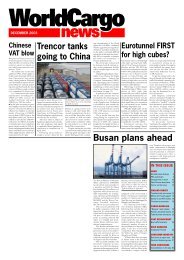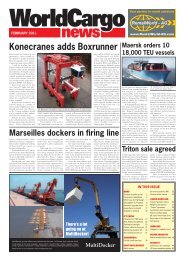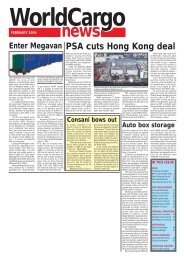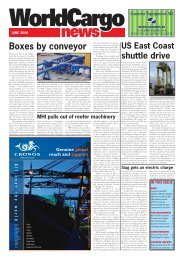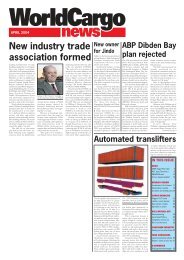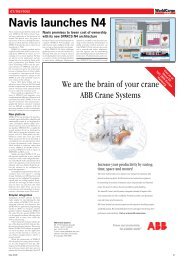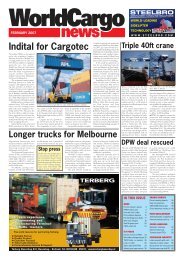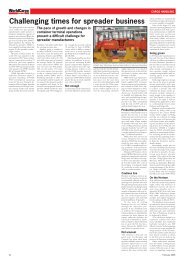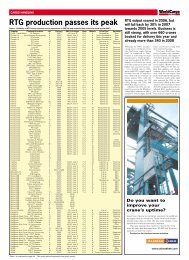WCN Sept Front page - WorldCargo News Online
WCN Sept Front page - WorldCargo News Online
WCN Sept Front page - WorldCargo News Online
Create successful ePaper yourself
Turn your PDF publications into a flip-book with our unique Google optimized e-Paper software.
<strong>WorldCargo</strong><br />
news<br />
Ro-ro in the South Pacific<br />
While new and used vehicles are the main<br />
international cargo, general cargo ro-ro occupies an<br />
important niche in coastal shipping in Australasia<br />
Wallenius Wilhelmsen Lines<br />
(WWL) serves the Australasian<br />
market with weekly ro-ro services<br />
linking Australia and New<br />
Zealand with Europe, South Africa<br />
and the Americas.<br />
Regional director Peter Dexter<br />
says that vehicle and heavy machinery<br />
imports have increased<br />
but there has also been strong<br />
growth in project cargo, such as<br />
rail cars, wind turbines and other<br />
outsized loads. The core market,<br />
however, remains vehicles and<br />
WWL has expanded into 3PL to<br />
extend its influence. Oceania Vehicle<br />
Processors operates from<br />
seven sites across Australia and has<br />
taken its market share from one<br />
to 11 per cent since it was established<br />
three years ago. Another<br />
subsidiary, AgReady, was set up<br />
for heavy machinery.<br />
Inadequate<br />
While recognising that urban<br />
ports the world over are under<br />
pressure from competing land uses<br />
and that vehicle terminals are particularly<br />
land-hungry, Dexter is<br />
concerned that existing ro-ro facilities<br />
at Sydney, Auckland and<br />
Fremantle in particular are inadequate.<br />
He adds that ro-ro is not<br />
getting “the attention it requires”<br />
as ports plan future developments.<br />
Auckland and Sydney are under<br />
pressure to release their inner<br />
harbours for urban and recreational<br />
space. WWL currently uses<br />
Patrick’s Darling harbour terminal<br />
in Sydney (not the new Australian<br />
Automotive Terminal JV<br />
with P&O Ports) and is mulling<br />
options for when the lease expires<br />
in 2006.<br />
Port Kembla is frequently<br />
mooted as an alternative to Sydney<br />
but Dexter says customers<br />
want their vehicles unloaded in<br />
Sydney and “from a shipping<br />
company perspective, we have to<br />
do what they want.” Hubbing at<br />
Brisbane or Melbourne and using<br />
rail to access the Sydney market<br />
is not really viable at this juncture,<br />
says Dexter, as “intermodal<br />
service still has a long way to go.”<br />
In any case rail is not suitable for<br />
outsize machinery shipments.<br />
Kiwi Car Carriers (now part<br />
of Hual group through its owner<br />
Leif Høegh & Co ASA) hubs<br />
through Brisbane, but at 3500 vehicles/year<br />
it is a small player in<br />
the Australian market. General<br />
manager Terry Riches says the<br />
decision to limit service to one call<br />
at Brisbane was made to minimise<br />
deviation from the Japan-NZ<br />
route and not as part of a wider<br />
intermodal strategy.<br />
Kiwi boom continues<br />
A predicted slowdown in used<br />
vehicle imports from Japan into<br />
NZ does not look like eventuating.<br />
In 2002 demand for vessel<br />
space surged as importers rushed<br />
to build inventories before new<br />
regulations effectively prohibiting<br />
cars over five years old from being<br />
imported came into force.<br />
Kiwi Car Carriers is the main<br />
player on the Japan/NZ route<br />
with around one third market<br />
share. Riches says volume was up<br />
around three per cent last year to<br />
65,000 vehicles and he expects<br />
another 5-7 per cent growth this<br />
year. The service has been extended<br />
to cover Nelson and<br />
Picton in South Island through an<br />
arrangement with domestic<br />
coastal line Strait Shipping. Vehicles<br />
are transhipped in Wellington<br />
onto Strait’s inter-island service.<br />
Kiwi has won market share by<br />
Toll now uses the Swedish-designed<br />
SRC AutoTrestle system on three<br />
ships. (Note: This <strong>WCN</strong> photo was<br />
taken in Gothenburg four years ago)<br />
setting up a terminal logistics and<br />
services company, Kiwi Terminal<br />
Services, that provides storage,<br />
cleaning and certification services<br />
in both Japan and NZ. This has<br />
become more expensive recently<br />
after the Ministry of Agriculture<br />
and Forestry increased the “efficacy<br />
rate” of vehicle inspections<br />
to try and reduce quarantine risks.<br />
Inspections now take more<br />
time and 60-70 per cent of vehicles<br />
now require a full clean before<br />
shipping. From 2006, vehicles<br />
must be emissions-tested and<br />
Riches sees no reason why this<br />
cannot be done in Japan as well.<br />
One way ticket<br />
When Hual purchased Kiwi in<br />
2001 its aim was to generate revenue<br />
from the long journey back<br />
to Japan. However, the pressure for<br />
import service frequency is such<br />
that vessel operators are not currently<br />
driving efforts to find return<br />
cargo. Part of the problem for<br />
Kiwi is that its current fleet is not<br />
well suited to carrying forest products,<br />
although MDF board is carried<br />
from Lyttelton to Japan for<br />
Carter Holt Harvey,<br />
There is an opportunity for<br />
Hual to redeploy vessels more suitable<br />
for general cargo on the route,<br />
as it takes delivery of seven new<br />
vessels currently on order for other<br />
trade lanes. But, says Riches, the<br />
service will still have to run a very<br />
high frequency, so extra port time<br />
would not be welcome.<br />
The same high demand is<br />
keeping WWL from seeking more<br />
cargo for the trans-Tasman leg of<br />
its Europe/Oceania service. This<br />
service calls at Manzanillo, Papeete<br />
and Auckland on its way to Brisbane.<br />
Some sawn timber destined<br />
for the Australian market is loaded<br />
at Auckland but most of the available<br />
cargo is at Tauranga. Dexter<br />
says pressure on service frequency<br />
is such that “way port” deviations<br />
ROLL-ON/ROLL-OFF<br />
to collect additional cargo are not<br />
being considered at this time.<br />
Toll over Bass<br />
Since it purchased Bass Strait operator<br />
Brambles in November<br />
2002, Toll has invested in vessel<br />
upgrades and equipment to improve<br />
the capacity of the ro-ro<br />
operation. Its vessels TASMANIAN<br />
ACHIEVER and VICTORIAN RELIANCE,<br />
have been extended by 32m, increasing<br />
their capacity from 7600<br />
to 11,200 swt, sufficient for an<br />
extra 44 rolltrailers per trip.<br />
Toll Shipping’s sales manager<br />
Simon Hine says that, although<br />
Bass Straight volumes are not<br />
growing strongly, the extra capacity<br />
allows the vessels to carry all<br />
its business during peak periods.<br />
AutoTrestles fitted<br />
As part of the refit process, Toll has<br />
adapted the vessels for use with<br />
the SAT AutoTrestle system designed<br />
by SRC Scandinavian Ro<br />
Ro Consultants (and now built by<br />
Novatech in Poland). As previously<br />
reported, the AutoTrestle is<br />
a platform that is coupled directly<br />
to the trailer kingpin and moved<br />
with the trailer by the terminal<br />
tractor. The trestle can be automatically<br />
clamped to the deck of<br />
the vessel by four twistlocks (larger<br />
than conventional container<br />
twistlocks) that are actuated from<br />
the terminal tractor.<br />
Toll staff saw the system when<br />
in Europe last year looking for a<br />
charter to fill the gap while<br />
ACHIEVER and RELIANCE were extended.<br />
During their refit the vessels<br />
were fitted with the deck pots<br />
for the trestle pins and 50 trestles<br />
were also delivered on TOR<br />
FUTURA, the vessel chartered for<br />
temporary Bass Strait service. Toll<br />
also bought six used Terberg RT22<br />
tractors in Europe, which were<br />
refurbished prior to shipment.<br />
Cutting costs<br />
Consolidating all its business with<br />
Toll Shipping has affected Patrick’s<br />
Bass Strait volumes. In its report<br />
on performance for the half year<br />
ended 31 March, Patrick Corporation<br />
noted: “Flowing from significant<br />
market overcapacity, the<br />
performance of the shipping operation<br />
continued to show an unacceptable<br />
level of return on funds<br />
employed in the period.”<br />
Over the last two years Patrick<br />
has completed upgrade projects its<br />
Devonport (Tasmania) and Webb<br />
Dock (Melbourne) terminals. At<br />
Devonport Patrick relocated the<br />
facilities of Patrick Tasmania (formerly<br />
Holyman Transport) to a<br />
new site next to the Patrick Shipping<br />
terminal. This effectively increased<br />
the storage area and elimi-<br />
8000-car PCTCs<br />
Wallenius Lines AB has placed an<br />
order for three new PCTCs that<br />
will be the biggest in the world:<br />
228m long and capable of carrying<br />
8000 cars. Earlier this year,<br />
Wallenius ordered three ships with<br />
a capacity of 6500 cars from<br />
Daewoo and announced that it<br />
was to extend five of the fleet’s<br />
BOHEME class vessels by 28m to<br />
228m, increasing their capacity by<br />
20 per cent to 7100 cars (World-<br />
Cargo <strong>News</strong>, April 2004, p16).<br />
The investment in the new and<br />
lengthened vessels is US$450 mill.<br />
“We are adapting to market requirements<br />
and once again leading<br />
the technical development of<br />
car carriers,” said Wallenius’ president<br />
Christer Olsson.<br />
“The ability to load more<br />
cargo on to each vessel means<br />
an increase in efficiency, not<br />
least from an environmental<br />
perspective.”<br />
Five of the ships will be built<br />
by Daewoo. As previously disclosed,<br />
the first two new ones will<br />
have a capacity of 6700 cars and<br />
will be delivered at the end of<br />
2006. The other three, each with<br />
a cargo capacity of 8000 cars, will<br />
be delivered in late 2007 and early<br />
2008. The ships will be operated<br />
by Wallenius Wilhelmsen Lines.<br />
The sixth ship, with a capacity<br />
of 6400 vehicles, is being built at<br />
Hyundai in Korea and will be<br />
operated by Wallenius’ Korean<br />
joint venture, Eukor.<br />
The lengthening of five ships<br />
will be carried out by Hyundai<br />
Mipo Dockyards, at its yard in Vietnam<br />
- Hyundai Vinashin Shipyard.<br />
MIGNON, ELEKTRA, BOHEME,<br />
MANON and UNDINE will be extended<br />
during 2005.<br />
Once all six vessels have been<br />
delivered, Wallenius will have at its<br />
disposal a fleet of approximately<br />
50 PCTCs that will be operated<br />
by various affiliates. ❏<br />
42<br />
<strong>Sept</strong>ember 2004



